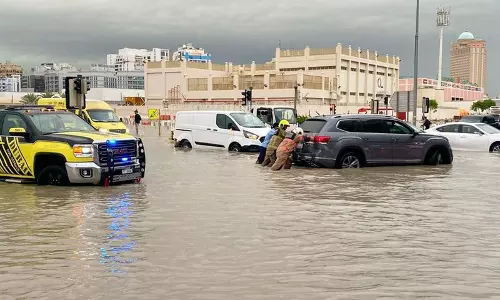
One-size-fits-all method for groundwater recharge may not work in India: Experts
text_fieldsNew Delhi: With the threat of many Indian cities running out of groundwater by 2020 looming large, experts say that a one-size-fits-all solution to recharge the country's aquifers is unlikely to work for all the states.
Hydrologists, geologists and other experts believe that a multi-pronged approach is imperative, as not just the traditionally dry areas, but even the Indus-Ganga-Brahmaputra basin -- the planet's richest groundwater reservoir -- is at the risk of long spells of drought.
Estimates show that India consists of only a little more than two per cent of the world's total land area, but supports 19 per cent of the global population, making it inherently stressed for natural resources for its citizens.
A NITI Aayog report in June estimated that 21 Indian cities will run out of groundwater by 2020 -- a bleak scenario for a country where 75 per cent of the domestic water sectors and 80 per cent of agriculture irrigation are reliant on groundwater.
"India is living beyond its available water resources. Initially, it was thought that only traditionally water-scarce, western India and parts of southern India are getting parched, said Abhijit Mukherjee, associate professor of hydrogeology at the Indian Institute of Technology (IIT) Kharagpur.
"However, in last couple of summers, unprecedented water worries are showing up even in the maps of eastern India, which have been historically known to be water affluent, and host some of the largest groundwater basins in the world," Mukherjee told PTI.
Widespread occurrences of natural groundwater contaminants along with emerging pollutants, increasing food demand associated with growing population, and effects of climate change have further compounded the problem, he said.
The government, Mukherjee said, has taken stock, and plans to supply piped drinking water to every household by 2024.
"A nationwide effort to artificially recharge the groundwater has started under MNREGA programme and parched water harvesting structures across the country is getting reviewed," Mukherjee added.
The propositions, he said, are "in good spirit and intent" but have not kept in mind the scientific principles that govern groundwater recharge.
Water resource availability is extremely heterogeneous and largely dependent on the topography, geological -- soft sediment or hard rock -- and climatic setup (mostly as rainfall) for an area, along with human usage, mostly for food production through irrigated agriculture.
Groundwater storage is influenced primarily by a very delicate balance of certain factors, which needs a detailed scientific evaluation and understanding.
Explaining these factors, Mukherjee said, "Every year, the groundwater of an area is typically recharged by rainfall, particularly during the monsoon."
However, the process of subsurface recharge is very slow.
"Depending on the depth of the wells, these waters could have recharged hundreds and thousands of years ago. Further, the excess water from the rainfall and floods does not get recharged into groundwater because of the geology and physics of the areas, Mukherjee said.
For example, groundwater in Kolkata or Patna gets recharged about a hundred kilometres away. Hence, in a human-time scale the groundwater we extract is theoretically a non-renewable resource, Mukherjee said.
There may be some good news though.
Groundwater rejuvenation has been reported in parts of Gujarat, Andhra Pradesh, and Madhya Pradesh.
Mukherjee attributed this to the implementation of ingenious groundwater management strategies in both public and private sectors.
But he warned against cheering for these too soon.
"All areas do not have the same topographic-geological-climatic setup of Gujarat or Andhra Pradesh, which is why this country-scale artificial recharge has several scientific issues, Mukherjee said.
Further, the groundwater and river water in an area are in a very delicate balance that is maintained by the physics of the water. Any plan to augment the groundwater would also have serious implications for rivers in the vicinity.
However, A L Ramanathan from the Jawaharlal Nehru University (JNU) in New Delhi attributed the water crisis to saltwater intrusion and pollution in 30 per cent of the places.
But in 70 per cent of the cases there is "hope to revise it by watershed management, urban water management, checking dams, traditional pond rejuvenation etc," he said.
D Nagesh Kumar, head of Center of Earth Science at the Indian Institute of Science (IISc) Bangalore, agreed.
"Over-exploitation of groundwater resources due to heavy power subsidy to farmers is the most responsible factor," Kumar said.
According to D C Singhal, president of the Indian National Committee of International Association of Hydrologists (IAH), the crisis can be averted using methods of artificial groundwater recharge, especially in coastal areas, to arrest seawater inclusion, and by adopting rainwater harvesting, and by making this mandatory in urban areas.
He said it can also be achieved by increasing practices of water conservation like the new project to store river flood flows taken up by the Delhi government in the Yamuna floodplain of Delhi-NCR.























